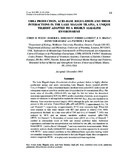Urea Production, Acid-base Regulation And Their Interactions In The Lake Magadi Tilapia, A Unique Teleost Adapted To A Highly Alkaline Environment

View/
Date
1994Author
Wood, C
Bergman, H
Laurent, P
Maina, JN
Narahara, A
Walsh, P
Type
ArticleLanguage
enMetadata
Show full item recordAbstract
The Lake Magadi tilapia, Oreochromis alcalicus grahami, thrives in highly alkaline
geothermal springs and pools surrounding Lake Magadi, Kenya (control pH=9.9,
CCO·=173mmoll21), has a functional hepatic ornithine–urea cycle (OUC) and excretes all
nitrogenous waste as urea-N at variable rates (JUrea) related to O2 consumption (M ·
O·). The
mean value of JUrea/M ·
O· (N/O2=0.183) was high for fish but below the theoretical
maximum (approximately 0.27) for 100 % aerobic respiration of protein, so an exogenous
source of substrates is not required to explain the observed JUrea. JUrea was insensitive to
thiourea. Urea excretion occurred largely (80 %) through the gills, but urea-N was also
present in bile and urine. Control blood pHe, pHi and [HCO32] (approximately 8.1, 7.6
and 15mmoll21, respectively, at approximately 32 °C) were extremely high. When fish
were exposed to lake water titrated with HCl and aerated to remove CO2, N/O2
progressively declined. At a lake water pH of 7.05 and CCO· of 0mmoll21, N/O2 was
reduced by 80 % and an intense metabolic acidosis occurred (pHe=7.04,
[HCO32]=1.5mmoll21). Restoration of control water pH 9.9 at a CCO· of 0mmoll21
resulted in intermediate levels of N/O2 and internal acid–base status. Additional
experiments confirmed that urea production was inhibited by low pHe, was dependent on
blood [HCO32] with a Km of 3.06mmoll21 and was insensitive to acetazolamide. While
metabolic acidosis clearly inhibited OUC ureagenesis, the system appeared to be saturated
with HCO32 under control conditions so that additional basic equivalent loading would
not stimulate ureagenesis. Urea production in the Lake Magadi tilapia does not appear to
remove exogenous HCO32 or to play a role in normal acid–base regulation.
URI
http://jeb.biologists.org/content/189/1/13.full.pdfhttp://erepository.uonbi.ac.ke:8080/xmlui/handle/123456789/50173
Citation
J. exp. Biol. 189, 13–36 (1994)Publisher
Department of Biology, McMaster University, Hamilton, Ontario, Canada L8S 4K1, Department of Veterinary Anatomy, University of Nairobi Department of Zoology and Physiology, University of Wyoming, Laramie, WY 82071,
Subject
Lake MagadiUrea
Acid–base balance
High pH
Liver
Ornithine–urea cycle
Ammonia
Glutamine
Oreochromis alcalicus grahami
